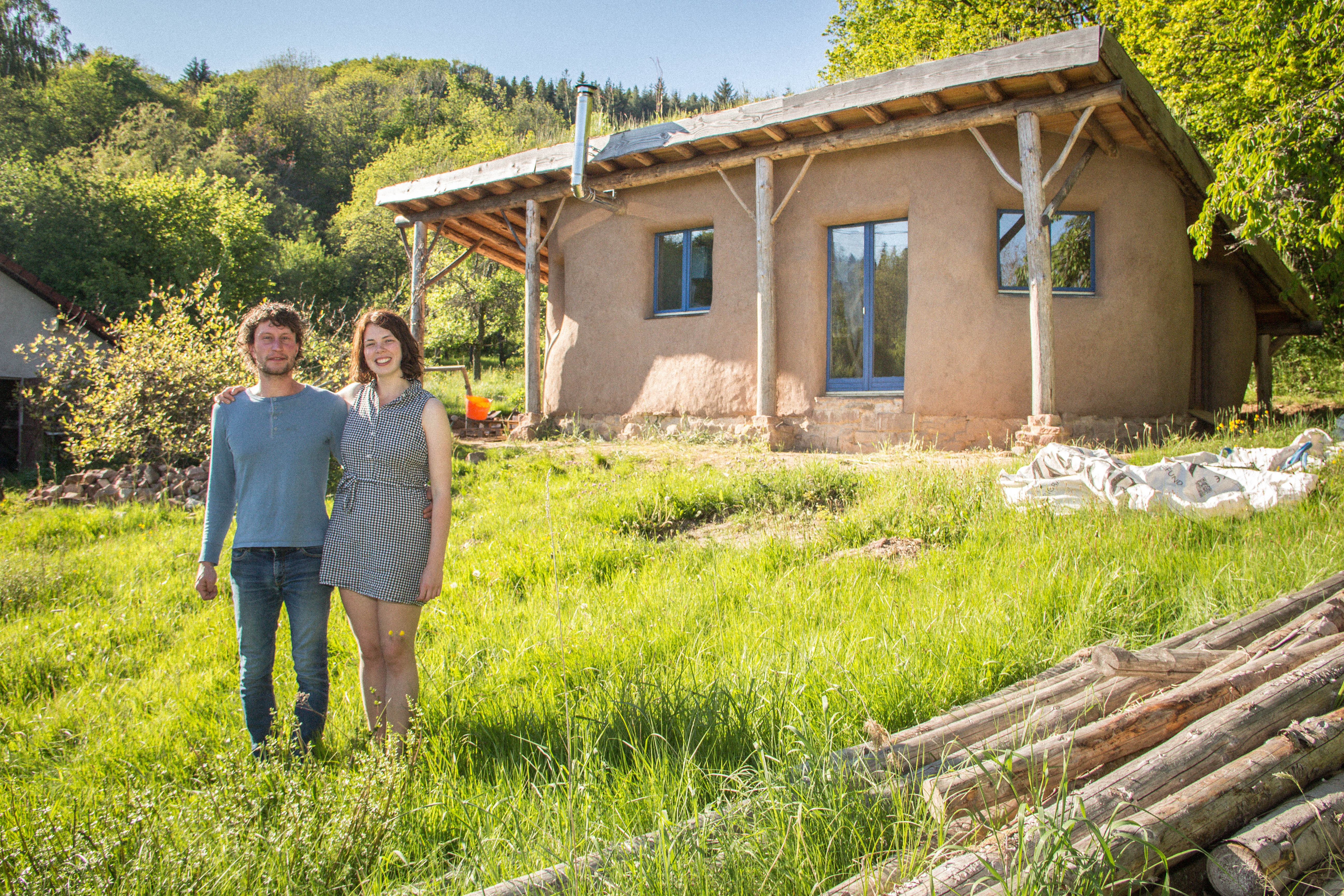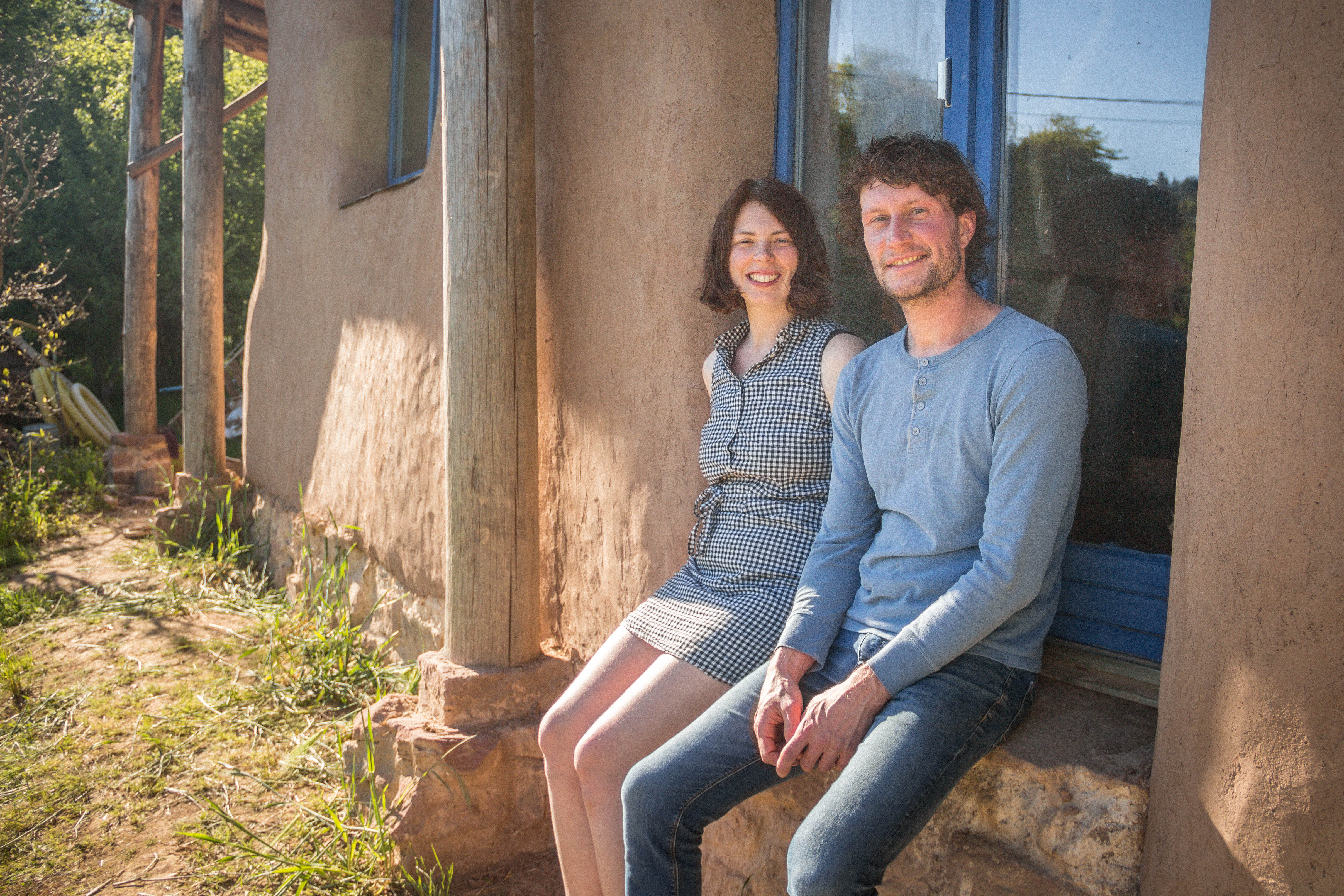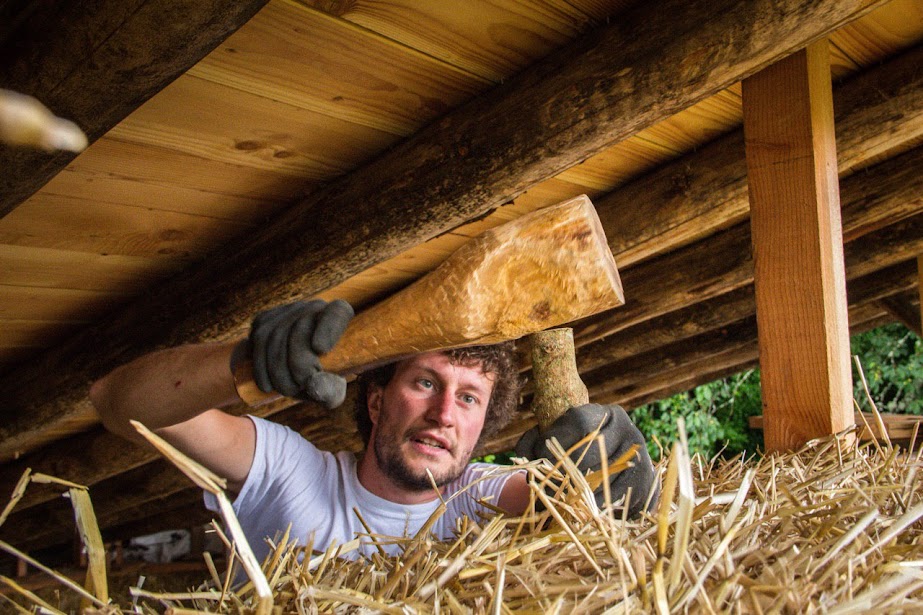Habiter la terre is the life project of Louise McKeever and Mathieu Munsch, based in the village of La-Grande-Fosse in the Vosges Natural Regional Park. We aim to promote autonomous living practices rooted in an understanding and respect of nature. Through sharing the skills acquired through carving a life out of the land around us, we aim to empower others to take steps towards regaining their own autonomy and to cultivate resilience at the level of our local community.
After spending our twenties living in the city and pursuing careers in academia, we moved to a rural village of 130 people in the middle of the Vosges Natural Regional Park in an attempt to experiment with a lifestyle rooted in an understanding and respect of nature as well as to empower others to follow in our footsteps. Having both had experience teaching at university and training in popular education, we are now using our skills as educators to share our experience of land-based living with individuals who seek to reconnect their lifestyle with nature.
We began by self-building our own home using only natural and reclaimed material and designed according to principles of solar passivity and energy self-sufficiency. We did a call-out for volunteers during the building process, and empowered 75 people aged 16 to 35 with natural building skills in timber-framing, straw bale walls and earthen plasters. Now that our house is finished and that we are able to live in the village full-time, we are dedicating our time to teach land-based skills, pertaining to natural building as well as other autonomous living practices such as foraging for wild foods, fermentation and other preservation methods, tending to an orchard and weaving with willow and other natural fibres.
In addition to our work as educators, we are also active in local politics and community associations—some of which we have helped setting up, such as a community garden for the village. Thus, if we strive for autonomy in our lifestyle, our day-to-day work is dedicated to build such resilience not just for ourselves, but at the level of our local community in a way that cuts across age groups, individual backgrounds and political ideologies.
Please highlight how the project can be exemplary in this context
Our living space was designed to demonstrate ways in which houses can constitute a form of adaptation to climate change. The structure was designed to be solar-passive: the placement of the windows, the eaves of the roof, the material used outside and inside were all chosen so as to maximise the benefits of the sun's energy and to minimize the need for an external source of heating or cooling. The materials were chosen by taking into account both for their local availability as well as their insulative and thermal accumulation potentials.
Thus, the house was built (almost) exclusively using natural materials: foundations were laid using local stones and lime, the wall were raised using straw bales and plastered with our local earth, and the structure supporting the roof was raised with local Douglas firs felled from the forest nearby and used as round logs so as to minimize the energy impact that would have come from the milling process. The roof consists of the turf that was displaced when we laid out the foundations for our dwelling.
No concrete or cement was used during the whole build, and the whole structure was raised using only people power and hand tools. The only material that went into the house and which does not occur naturally is foam glass for insulating the floor, but its ecological impact is low as it is a product made from the recycling of discarded glass and car windshields.
Please highlight how the project can be exemplary in this context
The aesthetics qualities of our house derive purely from the innate beauty contained in natural materials. Indeed, great care was taken to make sure that all features visible both on the outside and on the inside of the house would bring out the inherent qualities of the materials that went into it. This was achieved by hand-building most of it, by sourcing material with character (such as gnarly branches, local stones, or local earths with interesting pigmentation) and to work with their specificities rather than to try to standardise them (by working with milled timber for instance). All colours used in the plaster were sourced and obtained from locally occurring veins of clay, so as to bring out the natural colours of our local environment and to showcase the beauty of vernacular building techniques.
On top of the aesthetic aspect, an earthen house also provides an excellent quality of life: all the earth used in our wall and our floor inside the house accumulate the sun's heat during the day to give it out at night, and the moisture contained in the air is constantly regulated by it. As such, an ideal environment for human health of around 60% humidity is maintained passively by the materials surrounding us, and harmful moulds are deterred from ever forming.
Please highlight how the project can be exemplary in this context
As mentioned in the summary, our house was built with the participation of 75 volunteers from all across Europe who came to learn the natural building skills that we were proposing. In addition, the engagement of villagers was also sought at various points during the build, which greatly helped with building trust between us and our soon-to-be neighbours, as well as to attenuate old grudges that may have formed over the years between different families by engaging them in a shared project.
Our core activity now consists in teaching the skills used in building our house, and our public engagement is thus continued long term. By rooting ourselves into a place and by contributing our energy to it (be it on a voluntary basis, or by occupying a position on the municipal council), we are instilling some life back into a rural part of the country that suffered greatly from deindustrialisation and a rural exodus throughout the second half of the last century.
On top of all this, it should be mentioned that the budget for our house amounted to a total cost of €16.000, which makes it highly replicable as a form of low-income, high performance housing.
Please highlight how this approach can be exemplary
This should be already be made self-evident from the answers to previous questions.
Finding the sweet spot where sustainability, quality of life/aesthetics and affordability intersect was made possible through the choice of materials, building techniques and clever design. Indeed, what our project has demonstrated first and foremost is that self-building high performance housing out of straw and clay at minimal cost is approachable to a large amount of people—whether they be building professionals or not. By doing so, we intended to set a replicable example for resilient rural living in the 21st century.
Buildings generate nearly 40% of annual greenhouse gas emissions. On top of that, the daily energy use of their users is to be added to their footprints over time. By hand-building smaller dwellings from natural material and by rediscovering vernacular crafts, the ecological impact of a building can be drastically reduced—if not brought down close to zero—as well as their long term energy costs.
Moreover, the impact that such a project has on the world cannot be reduced to its quantifiable ecological footprint, but also finds a place within a wider cultural change that its inhabitants manifest through living in the way that such a land-based lifestyle demands. Through the hosting of volunteers, and subsequently by organising public workshops, we have provided a few dozens of people with practical skills rooted in an understanding and respect for nature, but have also contributed to a shift in perspective that opens up new avenues of possibilities for new modes of life in a rural context that are at the vanguard of an ecological cultural change.
If anything, our project exemplifies that it is possible to live a purposeful life by centring care for the land and community. Moreover, it shows that it is also affordable to do so, and that Europe's neglected rural regions can be the centre ground of this cultural shift.
Please also explain the benefits that derived from their involvement.
As already mentioned, this project was implemented largely through a call-out for volunteers—75 of which participated over the course of the two summers that the house took to be built. On top of this, local inhabitants of our village were greatly invested in our project and its success. Some of them kindly offered materials (stones, wood, earths of interesting colours, reclaimed windows), expertise (carpentry or masonry advices), or a hand at times when we needed it the most.
Several people who came to help us on the build went on to start their own project of a similar nature, inspired by our architectural design, and a network of mutual aid is now being created between all these rural oases.
There are several benefits to such forms of involvement. Firstly, by operating in this way, the cost of building is radically reduced. Indeed, even though the materials required for such building methods are (quite literally) dirt cheap, they are very labour intensive and would not be competitive against conventional building methods if it was not for a volunteer-based approach. Secondly, a volunteer-based approach allows for the free sharing of skills, and leads some to develop a vocation that was denied to them in the traditional schooling system. Thirdly, by operating in a non-monetary way, people develop strong bonds with one another, a sense of community emerges and a network of mutual aid is allowed to grow—all of which are crucial in developing the resilience so needed in times of social and ecological upheavals.
Global issues such as climate change or the collapse of biodiversity find their roots in a global economic system that is blind to its externalities (be it ecological or social impact) and drives the continued extraction of the Earth's resources so long as somebody can marginally derive a profit from it.
Our project is an attempt at a radical departure from this global economic model, by recentring life at the local community level and valuing the global diversity of place-based specificities. While building with cement has become symptomatic of this process of global homogenisation driven by an economic system designed to favour the fast and the cheap, vernacular ecological buildings can provide a way to sidestep this juggernaut while fostering a cultural revival of local alternatives. Stones, plant fibres, wood, and—most importantly—earths, are readily available in any localities. People have built with them—and them only— for millennia and their reliability has been proven time and time again. It is high time they regain their place as the building blocks of our civilisations.
In order to answer this question, we must first clarify what is meant by "mainstream practices in the field of the project”. If it refers to the practices of the conventional building industry—i.e. erecting badly insulated, concrete blocks that put roove over people’s heads but very little else in terms of health, nature and community care—then our responses to previous questions should already have made the case for the innovative character of our project.
However, if what is meant in this question is what makes us stand out from projects of a similar nature, then three key innovations can be highlighted. Firstly, even though other organisations and building professionals have already gone to great length to demonstrate the benefits of natural buildings for human health and ecological sustainability, few have integrated architecture as part of a wider cultural change within a specific bioregion and to take it as just one of the many element of a re-rooting of oneself within a land-based lifestyle.
Secondly, because of the low cost aspect of our build (€16.000 for the whole house) and its non-professionalised and hand-crafted nature, our project was designed to be highly replicable, which is something that certainly cannot be said for many of the designs drawn up by architects in the ecological building community as they tend to be restricted to people with a certain amount of wealth.
Thirdly, we are both from an academic background, have both studied to PhD level and are trained as educators. While some building professionals may be incredibly skilled at their crafts, all may not have the pedagogy required to transfer their expertise and passion, which is something we on the other hand are confident in doing. Through sharing the knowledge and skills acquired through carving a life out of the land, we are well equipped to empower others to take steps towards regaining their own autonomy.
Please provide clear documentation, communication of methodology and principles in this context.
All materials used for our project can be easily sourced directly out of the local natural environment and are often acquired for free. The total cost of the build amounted to €16.000, and all the work was done by hand by people with no professional background in the building sector. As such, we estimate that the potential for the project to be replicated is very high.
In order to disseminate our learnings and empower as many people as possible to embark on similar projects, we have chosen to put the bulk of our efforts into face-to-face, hands-on teaching. Indeed, based on our own experience as self-builders, we have found in-person training to be the most efficient way of acquiring the right balance of theoretical knowledge and practical familiarity with the materials and techniques to be able to use them autonomously. We now organise regular workshops on different aspects of natural building, and offer assistance to self-builders on their building site. These workshops can be found on our website at www.habiterlaterre.com.
Secondly, we are part of a network of natural builders based in the Grand Est region which organises viewings of ecological houses for the public with detailed explanations on the materials, techniques and designs used, and receive guests as part of that.
Finally, we have exchanged messages with two media specialised in the field about coming for a visit to do a story on our project: La Maison Ecologique, a magazine which specialises on eco-buildings and which is the French-language reference in this field, and L'Archipelle, a Youtube channel followed by over 200.000 people and which specialises in autonomous lifestyles. We expect these two stories to be written/filmed later this year.
Included is the documentation submitted to apply for a building permit. It is free to be disseminated so that others can use it as inspiration for similar projects.





@MathieuMunsch, 2021
Content licensed to the European Union.